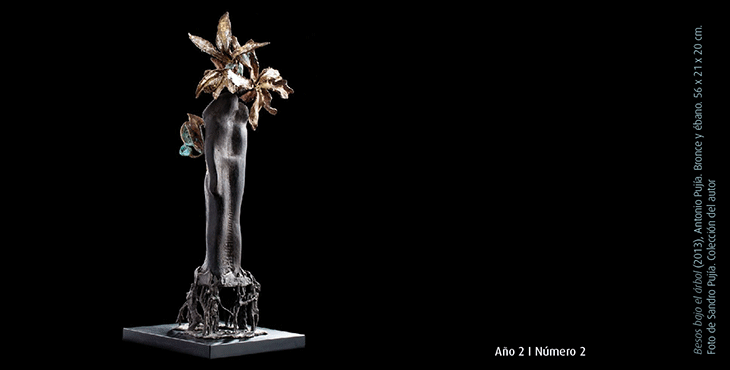Music and Remnants of History. Ideological Artifacts and Positivism in the History of Music
DOI:
https://doi.org/10.24215/25457888e003Keywords:
Music historiography, positivism, musical fetishism, musical workAbstract
Although in the last decades there has been a renewal of musicology, the maintopics of positivism are still in the center of textbooks and curriculum of musichistory. This historiography has become hegemonic, showing great resistancecompared to other historical disciplines. One of the usual explanations is thatof a disciplinary delay: positivism has come late to an isolated musicology,concerned only in its problems. In this paper I will try an alternative explanation,appealing to the fact that this paradigm dwells in its own artifacts: in particularthe work and style concepts. In this way I will propose the existence of aspecifically musicological positivism, and also consider the possibility that itshegemony rests on ideological rather than methodological reasons.Downloads
References
Attali, J. (1995). Ruidos: Ensayo sobre la economía política de la música. Ciudad de México, México: Siglo Veintiuno.
Beard, D. y Gloag, K. (2005). Musicology: the key Concepts [Musicología: conceptos clave]. Nueva York, Estados Unidos: Routledge.
Bermúdez, E. (1982). La pobreza del positivismo. Recuperado de https://www.academia.edu/33884388/La_pobreza_del_positivismo_el_quehacer_musicologico_en_Am%C3%A9rica_Latina
Carr, E. (2006). ¿Qué es la historia? Barcelona, España: Ariel.
Claro Valdés, S. (1967). Hacia una definición del concepto de musicología: Contribución a la musicología hispanoamericana. Revista Musical Chilena, (100), 8-25. Recuperado de https://revistamusicalchilena.uchile.cl/index.php/RMCH/article/view/14458/14771
Dahlhaus, C. (1997). Fundamentos de la historia de la música. Barcelona, España: Gedisa.
Duckles, V., Passler, J. y otros (2001). Musicology [Musicología]. In The New Grove Dictionary of Music and Musicians [Nuevo Diccionario Grove de la Música y los Músicos]. Nueva York, Estados Unidos: Oxford University Press
Eagleton, T. (2006). La estética como ideología. Madrid, España: Trotta.
Eco, U. (2002). La definición del arte. Barcelona, España: Destino.
Fubini, E. (2005). La estética musical desde la antigüedad hasta el siglo XX. Madrid, España: Alianza.
Ginzburg, C. (1993). El juez y el historiador. Consideraciones al margen del proceso Sofri. Madrid, España: Anaya & Mario Muchnik.
Goehr, L. (1992). The imaginary museum of musical works: an essay in the philosophy of music [El museo imaginario de las obras musicales: un ensayo de filosofía musical]. Oxford, Inglaterra: Clarendon Press.
Gombrich, E. (2004). Breve historia de la cultura. Ciudad de México, México: Océano.
Hepokoski, J. (1991). The Dahlhaus Project and Its Extra-Musicological Sources [El proyecto Dahlhaus y sus fuentes extra-musicológicas]. 19th-Century Music, 14(3), 221-246.
Hobsbawm, E. (2015). The invention of tradition [La invención de la tradición]. Cambridge, Inglaterra: Cambridge University Press.
Kerman, J. (1985). Contemplating music: Challenges to musicology [Contemplando la música: desafíos de la musicología]. Cambridge, Estados Unidos: Harvard University Press.
Kerman, J. y Tomlinson, G. (2012). Listen: Eighth edition [Escuchar: octava edición]. Nueva York, Estados Unidos: St. Martin’s Press.
Korsyn, K. (2003). Decentering music: A critique of contemporary musical research [Descentrando la música: una crítica a la investigación musical contemporánea]. Oxford, Inglaterra: Oxford University Press.
Lanza, A. (1986). El siglo XX: Tercera parte. Madrid, España: Turner.
Marcuse, H. (1978). Cultura y sociedad. Buenos Aires, Argentina: Sur.
Meyer, L. (1956). Emotion and meaning in music [La emoción y el significado en la música]. Chicago, Estados Unidos: University of Chicago Press.
Pérez González, J. (2010). Las historias de la música en Hispanoamérica (1876-2000). Bogotá, Colombia: Universidad Nacional de Colombia.
Popper, K. (1957). La sociedad abierta y sus enemigos. Buenos Aires, Argentina: Paidós.
Rosen, Ch. (1986). El estilo clásico: Haydn, Mozart, Beethoven. Madrid, España: Alianza.
Samson, J. (2009). Music History [Historia musical]. En J. P. E. Harper Scott y J. Samson (eds.). An Introduction to Music Studies [Introducción a los estudios musicales]. Cambridge, Inglaterra: Cambridge University Press
Shreffler, A. (2003). Berlin Walls: Dahlhaus Knepler, and Ideologies of Music History [Los muros de Berlín: Dahlhaus, Knepler y las ideologías de la Historia de la Música]. The Journal of Musicology, 20(4), 498-525.
Small, Ch. (1999). El musicar: un ritual en el espacio social. Revista Transcultural de Música, (4), 3-5.
Small, Ch. (1991). Música, sociedad, educación: un examen de la función de la música en las culturas occidentales, orientales y africanas, que estudia su influencia sobre la sociedad y sus usos en la educación. Madrid, España: Alianza.
Stanley, G. (2001). Historiography [Historiografía]. In The New Grove Dictionary of Music and Musicians [Nuevo Diccionario Grove de la Música y los Músicos]. Nueva York, Estados Unidos: Oxford University Press.
Downloads
Published
How to Cite
Issue
Section
License
Current policy since 2019
The acceptance of the manuscript by the magazine means the non-exclusive cession of the property rights of the authors in favour of the editor, who allows the reuse, after publication (post print), under a license Attribution-NonCommercial-ShareAlikes 4.0 International (BY-NC-SA 4.0).
According to these terms, the material can be copied and redistributed by any means or in any format as long as a) the author and original source of the publication are quoted (magazine and URL of the work), access to the license is provided and whether changes have been made is mentioned; and b) the material is not used for commercial purposes.
The cession of non-exclusive rights means that after the publication (post print) in Armiliar the authors can publish their work in any language, means and format; in such cases it must be mentioned that the material was originally published in this magazine. Such cession also means the authorization of the authors for the work to be collected by SEDICI, the institutional archive of the Universidad Nacional de La Plata, and to be spread in the databases that the editorial team considers appropriate to increase the visibility of the publication and its authors.
Moreover, the magazine encourages the authors to deposit their productions in other institutional and thematic archives under the principle that offering the society the scientific and academic production without any restrictions contributes to a greater exchange of the global knowledge.



























